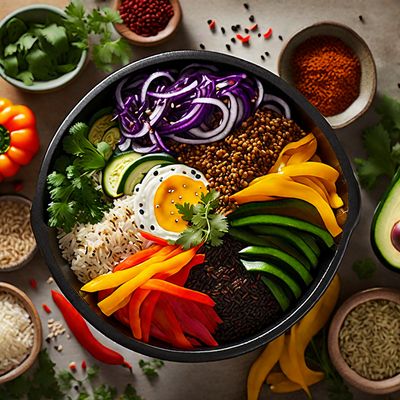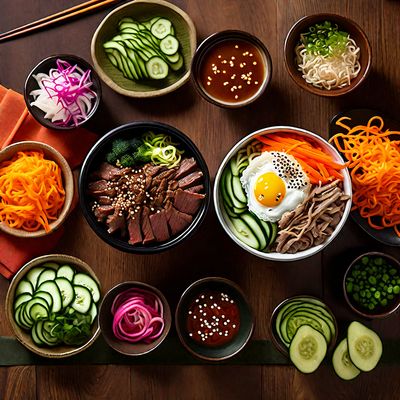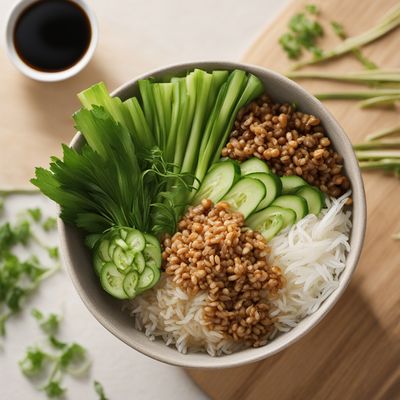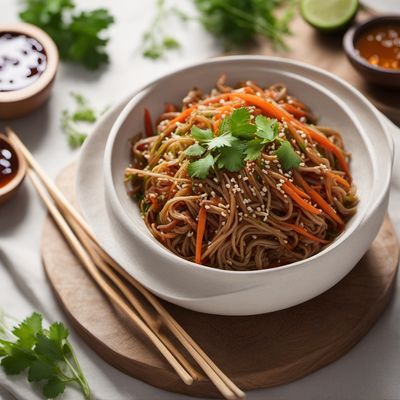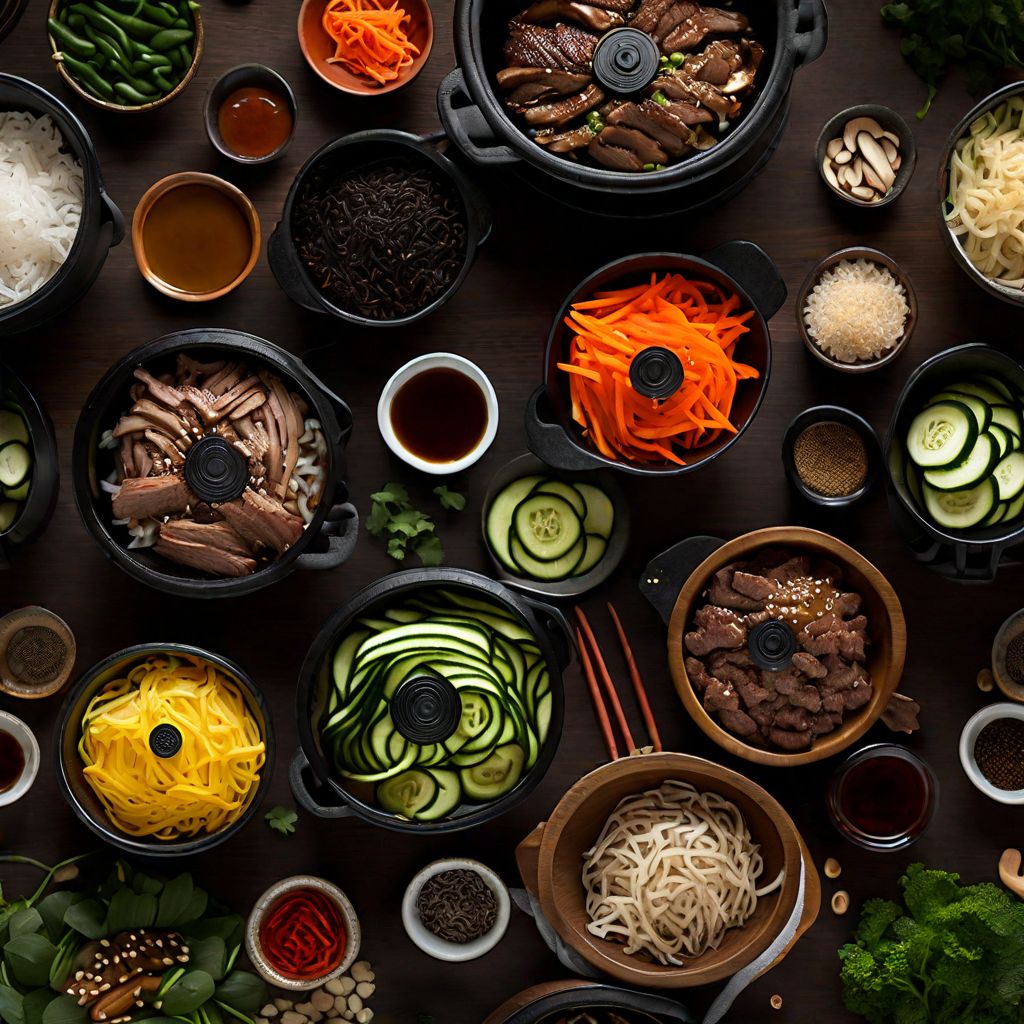
Recipe
Chinese-style Bibimbap
Savory Chinese Bibimbap: A Fusion of Flavors
4.9 out of 5
In the realm of Chinese cuisine, we present a delightful twist on the classic Korean dish, Bibimbap. This Chinese-style Bibimbap combines the essence of both cuisines, resulting in a harmonious blend of flavors and textures. With its vibrant colors and aromatic ingredients, this dish is sure to captivate your taste buds and transport you to the heart of Chinese culinary traditions.
Metadata
Preparation time
25 minutes
Cooking time
15 minutes
Total time
40 minutes
Yields
4 servings
Preparation difficulty
Medium
Suitable for
Gluten-free, Dairy-free, Nut-free, Low-carb, High-protein
Allergens
Soy, Oyster sauce
Not suitable for
Vegan, Vegetarian, Paleo, Keto, Halal
Ingredients
While the original Korean Bibimbap features a variety of vegetables, rice, and a spicy sauce, this Chinese adaptation incorporates Chinese flavors and ingredients. The Chinese-style Bibimbap includes a medley of stir-fried vegetables, marinated meat, and a savory sauce infused with Chinese spices. This fusion dish offers a unique twist on the traditional Bibimbap, showcasing the diversity and creativity of Chinese cuisine. We alse have the original recipe for Bibimbap, so you can check it out.
-
2 cups (470ml) cooked white rice 2 cups (470ml) cooked white rice
-
200g (7oz) beef, thinly sliced 200g (7oz) beef, thinly sliced
-
1 tablespoon vegetable oil 1 tablespoon vegetable oil
-
1 carrot, julienned 1 carrot, julienned
-
1 zucchini, julienned 1 zucchini, julienned
-
1 cup (150g) bean sprouts 1 cup (150g) bean sprouts
-
4 shiitake mushrooms, sliced 4 shiitake mushrooms, sliced
-
2 cloves garlic, minced 2 cloves garlic, minced
-
2 tablespoons soy sauce 2 tablespoons soy sauce
-
1 tablespoon oyster sauce 1 tablespoon oyster sauce
-
1 teaspoon sesame oil 1 teaspoon sesame oil
-
1 teaspoon sugar 1 teaspoon sugar
-
4 eggs 4 eggs
-
Salt and pepper to taste Salt and pepper to taste
-
Sesame seeds, for garnish Sesame seeds, for garnish
-
Spring onions, chopped, for garnish Spring onions, chopped, for garnish
Nutrition
- Calories (kcal / KJ): 450 kcal / 1884 KJ
- Fat (total, saturated): 12g, 3g
- Carbohydrates (total, sugars): 55g, 4g
- Protein: 28g
- Fiber: 5g
- Salt: 2g
Preparation
-
1.In a bowl, combine the beef, minced garlic, soy sauce, oyster sauce, sesame oil, and sugar. Mix well and let it marinate for 15 minutes.
-
2.Heat vegetable oil in a wok or large skillet over medium-high heat. Stir-fry the marinated beef until cooked through. Remove from the pan and set aside.
-
3.In the same pan, stir-fry the carrots, zucchini, bean sprouts, and shiitake mushrooms until tender-crisp. Season with salt and pepper to taste.
-
4.In a separate pan, fry the eggs sunny-side up or to your desired doneness.
-
5.To assemble the Chinese-style Bibimbap, divide the cooked rice among serving bowls. Arrange the stir-fried vegetables and beef on top of the rice.
-
6.Place a fried egg on each bowl and garnish with sesame seeds and chopped spring onions.
Treat your ingredients with care...
- Beef — For a tender and flavorful result, thinly slice the beef against the grain.
- Bean sprouts — Blanch the bean sprouts in boiling water for a minute before stir-frying to retain their crunchiness.
- Shiitake mushrooms — Soak dried shiitake mushrooms in warm water for 20 minutes to rehydrate before slicing.
Tips & Tricks
- Substitute the beef with chicken, pork, or tofu for a different protein option.
- Add a drizzle of chili oil or sprinkle of Chinese five-spice powder for an extra kick of flavor.
- Customize the stir-fried vegetables based on seasonal availability and personal preference.
- Use a non-stick pan to fry the eggs for easy flipping and removal.
- Serve the Chinese-style Bibimbap with a side of kimchi for a traditional Korean touch.
Serving advice
Serve the Chinese-style Bibimbap hot, allowing the flavors to meld together. Mix all the ingredients thoroughly before enjoying to fully experience the combination of textures and flavors.
Presentation advice
Present the Chinese-style Bibimbap in individual bowls, showcasing the vibrant colors of the ingredients. Garnish with a sprinkle of sesame seeds and chopped spring onions for an appealing visual touch.
More recipes...
For Bibimbap » Browse all
For Korean cuisine » Browse all
More Korean cuisine dishes » Browse all

Papparoti
Papparoti is a popular Malaysian coffee bun that is crispy on the outside and soft on the inside. It is a perfect snack for coffee lovers and is...
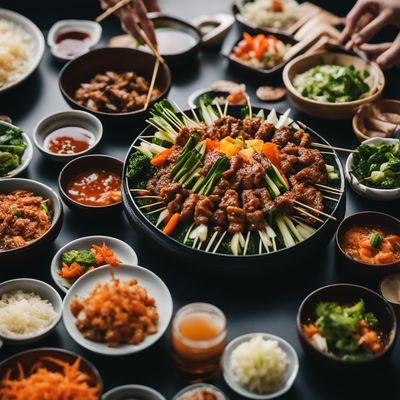
Sanjeok
Sanjeok is a traditional Korean dish that is made with skewered meat and vegetables. It is a popular dish for special occasions and celebrations,...

Leems
Leems is a traditional Korean side dish made from fermented vegetables. It is similar to sauerkraut or kimchi, but has a milder flavor and a...
More Chinese cuisine dishes » Browse all

Ling moong gai
Ling moong gai is a classic Chinese dish that is made with chicken and mung bean noodles. It is a light and healthy dish that is perfect for a...
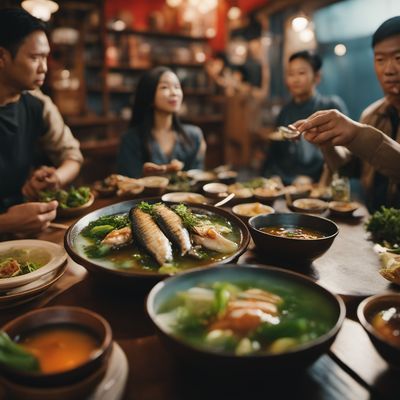
West Lake Vinegar Fish
Fish in vinegar sauce
West Lake Vinegar Fish is a classic Hangzhou dish made with freshwater fish and a sweet and sour vinegar sauce.
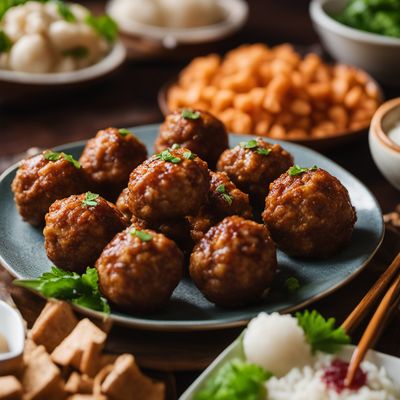
Pork Ball
Pork balls are a popular dish in many cultures, often served as an appetizer or snack. These savory meatballs are made with ground pork and a...
